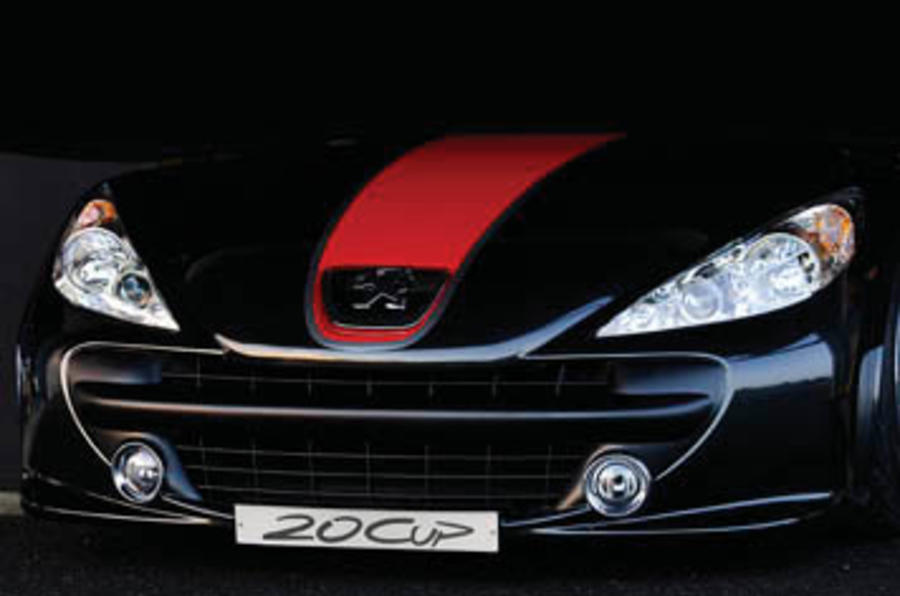SO FAR, this is the closest we’ve come to driving the 207 and, truth be told, it’s not all that close.
Peugeot’s 20Cup concept shares little more than its engine and the front-end styling with the production car, and certainly not the design of its rear, which looks, from the front three-quarter at least, like it’s been involved in a dreadful accident. And, thanks to an over-enthusiastic French journalist, one of the pair of 20Cups that Peugeot built already has been.
The other, pictured here, retains the motorcycle-style rear swingarm with single rear wheel that Peugeot intended. Sadly, that rear wheel isn’t the driven one; 20Cup is a front-driver like the production model, although considerably lighter: constructed mostly from carbon fibre, it weighs a shade under 500kg.
Around eighty percent of its weight is over the front wheels, so gets only a diddy disc to brake the huge rear wheel, shod with an intermediate tyre from a Le Mans prototype racer.
There are more racecar features further forward. The cabin’s spartan, with moulded carbon for seats, four-point harnesses, plumbed-in fire extinguisher and a six-speed sequential gearbox – as concept cars go, this is a very drivable one.
But that’s something Peugeot is adept at: the RC coupes spawned a race series and a 120mph spin in the V12-powered 907 nearly caused the demise of our own, passengering, Andrew Frankel.
Fortunately, there’ll be no ton-up experiences today. For one, we’re at the Mortefontaine test facility west of Paris – the French MIRA or Millbrook, if you like – where space is a little tight for 100mph speeds. And secondly, it’s throwing it down with rain so hard that I can barely see through my helmet visor, water’s sloshing about the cabin so that my legs are wetter than Coldplay and I can barely see over the vestigial wind-deflector.
Nevertheless, I find that the 20Cup’s 1.6-litre, 168bhp turbocharged engine is, in this application at least, a potent one. It develops most of its 177lb ft from low down in the rev-range and throws the 20Cup along at a fierce rate. It’s keen to rev and feels smooth throughout the rev-band, although judging its aural quality is rather difficult because of its bellowing exhaust.
The race ‘box and clutch shunt badly at low speeds, too, but it feels like a promising powerplant. Which, given it will power not only the 207 GTi, but several other Peugeots, Citroens and the next-generation Mini Cooper, it had better be.
Peugeot’s 20Cup concept shares little more than its engine and the front-end styling with the production car, and certainly not the design of its rear, which looks, from the front three-quarter at least, like it’s been involved in a dreadful accident. And, thanks to an over-enthusiastic French journalist, one of the pair of 20Cups that Peugeot built already has been.
The other, pictured here, retains the motorcycle-style rear swingarm with single rear wheel that Peugeot intended. Sadly, that rear wheel isn’t the driven one; 20Cup is a front-driver like the production model, although considerably lighter: constructed mostly from carbon fibre, it weighs a shade under 500kg.
Around eighty percent of its weight is over the front wheels, so gets only a diddy disc to brake the huge rear wheel, shod with an intermediate tyre from a Le Mans prototype racer.
There are more racecar features further forward. The cabin’s spartan, with moulded carbon for seats, four-point harnesses, plumbed-in fire extinguisher and a six-speed sequential gearbox – as concept cars go, this is a very drivable one.
But that’s something Peugeot is adept at: the RC coupes spawned a race series and a 120mph spin in the V12-powered 907 nearly caused the demise of our own, passengering, Andrew Frankel.
Fortunately, there’ll be no ton-up experiences today. For one, we’re at the Mortefontaine test facility west of Paris – the French MIRA or Millbrook, if you like – where space is a little tight for 100mph speeds. And secondly, it’s throwing it down with rain so hard that I can barely see through my helmet visor, water’s sloshing about the cabin so that my legs are wetter than Coldplay and I can barely see over the vestigial wind-deflector.
Nevertheless, I find that the 20Cup’s 1.6-litre, 168bhp turbocharged engine is, in this application at least, a potent one. It develops most of its 177lb ft from low down in the rev-range and throws the 20Cup along at a fierce rate. It’s keen to rev and feels smooth throughout the rev-band, although judging its aural quality is rather difficult because of its bellowing exhaust.
The race ‘box and clutch shunt badly at low speeds, too, but it feels like a promising powerplant. Which, given it will power not only the 207 GTi, but several other Peugeots, Citroens and the next-generation Mini Cooper, it had better be.



















Join the debate
Add your comment
I've read a great number of articles, and I must say that yours is among the best. I will investigate this article, so please do not fret. Try to become acquainted with me through conversation.
I've read a lot of articles, and I have to say that yours is among the best. Please do not worry; I will investigate this article. Try getting to know me by conversing with me.